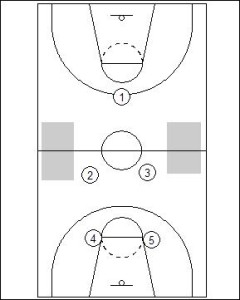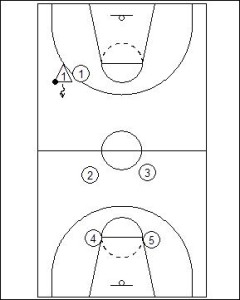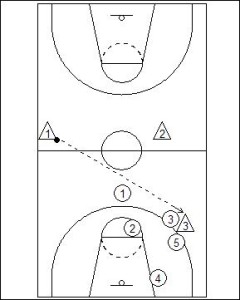1-2-2 Half Court Trap
Get the Right Advice the First Time
Get a E-Book on implementing the 1-2-2 Half Court Press written by Coaches, for Coaches. Learn about the best way to implement this powerful defensive strategy with your team witht he best E-Book on the market.
Click Here
The 1-2-2 Half Court Trap is one of the bread and butter defensive tactics every coach will utilise at least sometime in their coaching career. The 1-2-2 Half Court Trap provides further options for a coach to utilise in breaking an offensive team’s rhythm and style of play.
No team likes to play against a trapping defence. Most offensive teams at least initially will feel some anxiety when dealing with a press or trap. The 1-2-2 Half Court Trap builds this pressure through not only looking for the trapping opportunity but also starting to engage with the dribbler in the backcourt ensuring there is always pressure applied to wherever the ball is.
Another benefit of the 1-2-2 Half Court Trap is it can be used not only as an aggressive trapping defence, but also a stalling defence. By setting up in the 1-2-2 Half Court Trap alignment, most offensive teams will reduce the tempo or pace at which they play in the full court. This provides for the defensive team an opportunity to just slow the pace of the game and reduce the amount of time an offensive team will have in the half court to execute their offense.
When on court using the 1-2-2 Half Court Trap players must be willing to sprint to positions and communicate constantly to always cover the closest passing options for the offensive team. The aim of the players not involved in the trap directly is to never allow a pass to be executed to an offensive player who is one pass away from the dribbler. The best result for the defensive team, if a pass is conceded is for a slow pass in the air to be attempted by the offensive team. This will allow payers the best possible opportunity to try and intercept the pass or at the very least rotate to contain the offense.

The 1-2-2 Half Court Trap can be employed off a made basket or a free throw.
The players’ set-up on court with the Point Guard extended to the foul line on the defensive end of the floor.
The aim of the defensive team must be to attempt to keep the ball from coming to the middle of the court.
The two trapping areas as indicated in grey. It is worth noting that the 1-2-2 Half Court Trap can be executed on the backcourt or frontcourt side of the halfway line.
If however the 1-2-2 Half Court Trap is utilised on the frontcourt side, the halfway line becomes an additional defender that limits the ability of the ball handler to move substantially.

One (1) must look to channel the dribbler into one of the sidelines. This can be either side but the Point Guard (One) must not be beaten and always stay between the dribbler and split line.
As the ball carrier enters the frontcourt, Two (2) looks for the double-team and trap the ball.
Two (2) must not move too soon and should allow the ball carrier to think the sideline is the best option to dribble the ball into the front court.
Three (3) moves to cover the middle of the court.
Four (4) moves to cover down the sideline, looking to intercept any pass.
Five (5) is a safety but should also deny any pass to the top of the key.

If a horizontal pass is made the rotations are described below:
One (1) still takes the ball carrier, looking to channel the ball to the sideline again.
Three (3) will look to trap while Two (2) now covers the middle.
Five (5) will now take away the sideline pass and Four (4) defends the key.

If the vertical pass is made the rotations are as shown:
Five (5) and Three (3) will trap the ball, One (1) moves to cover the middle of the court.
Two (2) moves to defend at the baseline high post and Four (4) defends the baseline low post.

As can be seen in the above diagram the players must maintain two defenders trapping the ball, two interceptors and a safety.
Want more information about how you can make the 1-2-2 Halfcourt Press the hottest defense in your playbook? Look at FBC’s 1-2-2 Halfcourt Press E-Book!
Facebook
Twitter
LinkedIn

